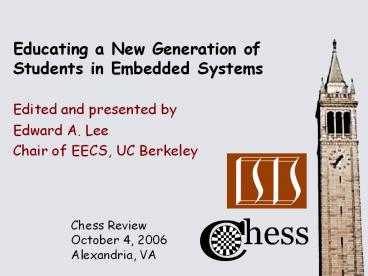Educating a New Generation of Students in Embedded Systems - PowerPoint PPT Presentation
Title:
Educating a New Generation of Students in Embedded Systems
Description:
The embedded revolution requires a reexamination and often a ... EECS145M/145L Microcomputer/electronics. EE125/128 Introductory controls and robotics ... – PowerPoint PPT presentation
Number of Views:32
Avg rating:3.0/5.0
Title: Educating a New Generation of Students in Embedded Systems
1
Educating a New Generation of Students in
Embedded Systems
- Edward A. Lee
- Chair of EECS, UC Berkeley
2
Statement of Principles
- Although computer-based embedded systems have
been designed for more than 30 years, they have
only recently emerged as an intellectual
discipline distinct from the applications and
distinct from both hardware and software
technologies. - The embedded revolution requires a
reexaminationand often a reinventionof core
abstractions of computing and systems
engineering. All effective abstractions hide
properties of the underlying systems, but the key
to their effectiveness is that they hide the
right properties. The core abstractions of
computing, for example, do not include time, yet
embedded computing systems depend critically on
predictable timing. Engineering education and
research needs to anticipate, shape, and guide
this transformation. This has to be done through
a partnership that includes specialists in
computing, electrical engineering, and the
application domains such as scientific
instrumentation, manufacturing systems,
automotive electronics, etc.
3
The Goal
- To create an integrated curriculum on
computational systems theory and systems design
practice with - Concurrency
- Composability
- Time
- Modularity
- Security
- Heterogeneity
- Verifiability
- Understandability
- This systems theory must be at once computational
and physical.
4
The Challenge
- Models for the physical world and for computation
diverge. - physical time continuum, ODEs, dynamics
- computational a procedural epistemology, logic
- There is a huge cultural gap.
- Physical system models must be viewed as semantic
frameworks, and theories of computation must be
viewed as alternative ways of talking about
dynamics.
5
Research and Education at Berkeley
Robotics and Unmanned Vehicles
Traffic control
Systems Biology
Habitat Monitoring
EE221A/222 Linear and Nonlinear Systems CE290I
Control and Information Management ME233 Advanced
Control CS270 Algorithms
Large research projects (e.g. PATH, GSRC, CHESS)
algorithms
Advanced courses (290 series)
EE 249 Embedded System Design EE290O Model
Integrated Computing EE290N Concurrent embedded
software EE291E Hybrid Systems
models
Graduate courses (e.g. EE249 Embedded System
Design Modeling, Validation and Synthesis)
CS262 Computer Networks EE192/ME102 Mechatronics
Design ME239 Advanced Design and
Automation EE228A High Speed Communication
Networks
system
Undergraduate courses (e.g. EE20 Structure and
Interpretation of Signals and Systems)
CS152/252 Architecture EE141/142/241/242 Analog
and Digital Design EECS145M/145L
Microcomputer/electronics EE125/128 Introductory
controls and robotics
micro architecture
EE20 Structure and Interpretation of Signals
and Systems
6
Build on our Introductory Course on Computational
Signals and Systems
Berkeley has a required sophomore course for EE
and CS students that addresses mathematical
modeling of signals and systems from a
computational perspective.
The web page at the right illustrates a broad
view of feedback, where the behavior is a fixed
point solution to a set of equations. This view
covers both traditional continuous feedback and
discrete-event systems.
The textbook
7
Current Role in EECS, Undergrad
eecs 20 structure and interpretation of signals
and systems
eecs 122 communication networks
eecs 120 signals and systems
eecs 126 probability and random processes
eecs 121 digital communication
eecs 123 digital signal processing
eecs 125 robotics
8
Future Role in EECS Undergrad
eecs 20 structure and interpretation of signals
and systems
eecs 122 communication networks
eecs xxx hybrid and embedded systems
eecs 120 signals and systems
eecs 126 probability and random processes
eecs xxx embedded software
eecs 121 digital communication
eecs 123 digital media signal processing
eecs 125 robotics
9
The EECS Department Commitment
- Has secured 1.5M for facilities, 0.5M for
equipment for an embedded systems design lab. - Will make embedded systems a priority area for
faculty hiring. - Will commit resources to course development and
instruction. - Will work with other College of Engineering
departments for maximum leverage. - Will re-examine the curriculum for appropriate
math, statistics, and computing requirements. - Will coordinate with outside leaders at peer
institutions worldwide.
10
Main entrance
Secondary entrance
Office of the Chair
Class- room
Classroom
Classroom
Main corridor
EECS reception
Instruc-tional lab
Under- graduate lounge
Honor society
Conference
Courtyard
Wong Wireless Foundations Center
National Instruments Embedded Systems Design Lab
Main elevators
Class- room
Classroom
Class- room
Classroom
11
Outreach to the College of EngineeringE.g.
CE290I Control Information Mgmt
Mathematical methods and information technologies
for controlling CEE systems. Emphasizes designing
component organizations that interact with the
world in real-time to control a large system.
Methods applied to transportation operations,
supply chains, and structures. Management of
design complexity by hierarchical specification,
systematic use of simulation and verification
tools, semantics, polymorphism, information
management services, and compilation from
high-level design languages.
Sengupta
12
Why Should We Lead The Way?
- We have long track record of shaping and defining
the core of the standard curriculum in several
engineering specialties. - We represent the strongest research programs in
embedded systems - wireless sensor networks
- model-based design
- embedded software
- configurable hardware
- hybrid systems modeling
- bio-mimetic systems
- wireless communications systems
- power-aware systems
- Our partners in the College of Engineering have
world-class research programs in manufacturing
systems, automotive electronics, process control,
mechatronics, transportation systems, and
eco-systems.
13
Involved Faculty at Berkeley
- Dave Auslander, Mechanical Engineering
- Ahmad Bahai, Electrical Engineering
- Alex Bayen, Civil and Environmental Engineering
- Eric Brewer, Computer Science
- David Culler, Computer Science
- Stephen Derenzo, Electrical Engineering
- Ron Fearing, Electrical Engineering
- Karl Hedrick, Mechanical Engineering
- Hami Kazerooni, Mechanical Engineering
- Kurt Keutzer, Electrical Engineering
- Ali M Niknejad, Electrical Engineering
- Kris Pister, Electrical Engineering
- Jan Rabaey, Electrical Engineering
- Alberto Sangiovanni-Vincentelli, Electrical
Engineering - Shankar Sastry, Electrical Engineering
- Raja Sengupta, Civil and Environmental
Engineering - Sanjit Seshia, Electrical Engineering
- Claire Tomlin, Electrical Engineering
- John Wawrzynek, Computer Science































